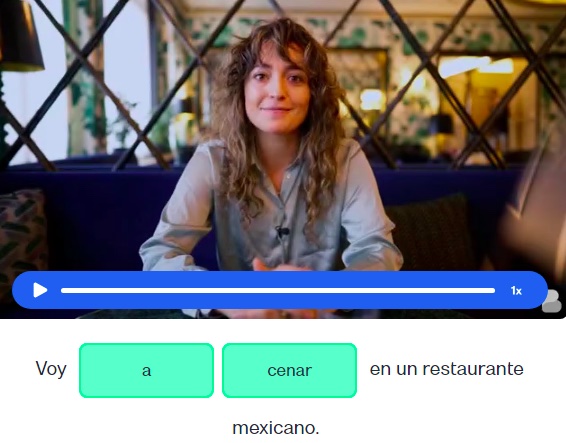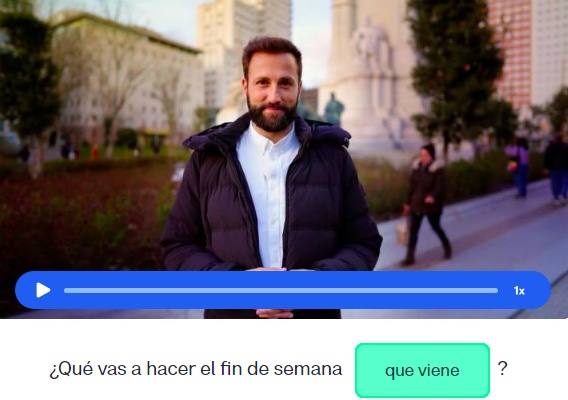Spanish Future Tense Conjugation: Guide and Overview
Learn the Spanish future tense conjugation to talk about plans and predictions.
I want to learn...
Being able to tell others about what you will do or what you predict in the future is a big part of how we use language. In Spanish, we can do this by using two important Spanish future forms: ir + a + infinitive and the futuro, the Spanish future tense.
Knowing how to use these two tenses will help you communicate your plans and intentions and even predict what you think will happen at a later time.
¡Comencemos!
Let’s begin!
Curious to know more about Spanish future tense conjugation?
You will learn that in the sentence “Voy a cenar en un restaurante mexicano.” The preposition we need after "ir" to express a plan is "a" (ir a + infinitive). Learn more future tense conjugation in Spanish via Busuu’s free online courses and learning resources!
Ir + a + infinitive: Making future plans
To talk about immediate future plans and intentions in Spanish, we can use ir + a + infinitive. The verb ir means “to go” in Spanish, and when combined with a (to) and another verb in its infinitive form, it roughly translates to “going to” + (action of the infinitive verb).
Here’s a simple example:
Voy a estudiar.
I am going to study.
It’s important to note that, unlike in English, with ir + a + infinitive you do not need to use the auxiliary verbs ser (to be) or estar (to be).
This can be confusing to some beginner Spanish speakers who try to translate a phrase directly into their head. In Spanish, saying “I am going to” is accomplished by using ir + a.
Let’s review how to conjugate the Spanish verb ir (to go) before we look at more examples.
Ir (to go): Present tense conjugation
| Pronoun | Conjugation |
|---|---|
| yo | voy |
| tú | vas |
| él/ella/usted | va |
| nosotros/nosotras | vamos |
| vosotros/vosotras | vais |
| ellos/ellas/ustedes | van |
Note: Vosotros/vosotras is mainly used in Spain and not in Latin America, where they tend to use usted/ustedes instead.
We can combine ir + a + infinitive with different expressions of time to specify when our plans will take place. Some commonly used expressions are:
- esta tarde: this afternoon
- mañana: tomorrow
- el viernes que viene/el próximo viernes: next Friday
- el fin de semana que viene/el próximo fin de semana: next weekend
- la semana que viene/la próxima semana: next week
Let’s look at some examples of using ir + a + infinitive with some of these expressions:
Voy a estudiar la semana que viene.
I am going to study next week.
Vas a viajar mañana.
You are going to travel tomorrow.
Ella va a comer en el restaurante el próximo miércoles.
She is going to eat at the restaurant next Wednesday.
Vamos a ver una película mañana.
We are going to watch a movie tomorrow.
Note: Essentially, “la semana que viene” highlights the immediate upcoming week, while “la próxima semana” simply indicates the week coming (next week) in a more general sense. However, the usage of these phrases can vary based on regional differences and personal preferences.
Now you’ve seen how to use ir + a + infinitive to talk about your immediate future plans and intentions. But what about those predictions we mentioned?
That’s where the futuro (future tense) comes in.
Spanish future tense conjugation: Regular and irregular verbs
We use the future tense to make general predictions about things that can happen or to state something that will happen after the present. It could mean anything from the weather tomorrow to your holiday plans next year.
Note: "ir + a + infinitive" is used for near future plans or intentions, while the Spanish future tense is used for more distant future events and actions that are certain or predictable, although their use depends on the speaker’s preference and on the context.
One great thing about Spanish future tense is that conjugating it is quite simple!
For all regular verbs ending in -ar, er, and ir, simply keep the verb in its infinitive form and add the following endings:
Future tense conjugation: All regular verbs
| Pronoun | Conjugation ending |
|---|---|
| yo | -é |
| tú | -ás |
| él/ella/usted | -á |
| nosotros/nosotras | -emos |
| vosotros/vosotras | -éis |
| ellos/ellas/ustedes | -án |
For a verb like hablar (to talk), that would look like this:
Future tense conjugation: Hablar (to talk)
| Pronoun | Conjugation |
|---|---|
| yo | hablaré |
| tú | hablarás |
| él/ella/usted | hablará |
| nosotros/nosotras | hablaremos |
| vosotros/vosotras | hablaréis |
| ellos/ellas/ustedes | hablarán |
Here are some example sentences using the future tense with regular verbs:
Tú hablarás con tu amigo esta tarde.
You will speak with your friend this afternoon.
Él cenará en un restaurante elegante.
He will have dinner at a fancy restaurant.
Nosotros bailaremos toda la noche.
We will dance all night.
Master the future tense for Spanish verbs
To talk about future moments in time, we add "que viene"— el año que viene, el mes que viene, etc. Practice using Spanish verbs in the future tense with Busuu’s free online courses and learning resources, together with a community of Spanish learners and native speakers!
Future tense conjugation: Irregular verbs
As with all tenses, irregular verbs require special mention. The following irregular verbs don’t keep their full infinitive form, but they do have the same future tense endings as regular verbs.
Let’s look at venir (to come) and tener (to have). In both of these verbs, the vowel in the infinitive (the i and the e, respectively) changes to a d. Then, we add the same verb ending as we do for regular verbs:
Conjugation of the Spanish verbs venir and tener
| venir (to come) | tener (to have) |
|---|---|
| vendré | tendré |
| vendrás | tendrás |
| vendrá | tendrá |
| vendremos | tendremos |
| vendréis | tendréis |
| vendrán | tendrán |
For poner (to put) and salir (to leave/to go out) we observe a similar pattern:
Conjugation of the Spanish verbs poner and tener
| poner (to put) | salir (to leave/go out) |
|---|---|
| pondré | saldré |
| pondrás | saldrás |
| pondrá | saldrá |
| pondremos | saldremos |
| pondréis | saldréis |
| pondrán | saldrán |
For verbs like decir and hacer, the c becomes an r, and the conjugations look like:
Conjugation of the Spanish verbs decir and hacer
| decir (to say/tell) | hacer (to do/make) |
|---|---|
| diré | haré |
| dirás | harás |
| dirá | hará |
| diremos | haremos |
| diréis | haréis |
| dirán | harán |
Note: With decir (to say/tell) the (e) also changes to an (i) when conjugated in the future tense.
And lastly, let’s look at querer (to want/love). For this verb, we simply add an extra r after dropping its -er ending. Because of this extra r, we have to adjust our pronunciation to make it a little stronger.
Conjugation of the Spanish verb querer
| querer (to want/love) |
|---|
| querré |
| querrás |
| querrá |
| querremos |
| querrréis |
| querrán |
Now that we’ve reviewed all of these different conjugations for irregular verbs, why don’t we look at some examples that use them?
Like with ir + a + infinitive, we can use time expressions to indicate when these actions will take place in the future when using the future tense.
Here are some examples of those previous expressions combined with irregular verbs in the future tense:
Mañana pondré los libros en la estantería.
Tomorrow, I will put the books on the shelf.
Saldré con mis amigos esta tarde.
I will go out with my friends this afternoon.
Él dirá la verdad en la reunión de mañana.
He will tell the truth at tomorrow's meeting.
Haremos una fiesta sorpresa para su cumpleaños la próxima semana.
We will throw a surprise party for their birthday next week.
Expressing future actions in Spanish: Recap
We have a couple of simple methods for talking about the future in Spanish: ir + a + infinitive and the futuro(future tense).
Ir + a + infinitive is used to talk about specific plans and intentions in the near future while the future tense is used to talk about general predictions or things that will happen in the future.
These two ways of speaking about the future are sometimes used interchangeably and their usage may depend on speaker preference and context.
Now you’re all set to start telling others about things that will happen in the future.
¡Buen trabajo!
Great work!
Want to keep the momentum going?
Busuu is here to help. With free online courses designed by language experts, you will never miss a beat to practice Spanish right at your fingertips.

